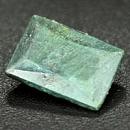|
|
||||||||||||||||
|
||||||||||||||||
|
||||||
|
|
|
|
Gormanite
|
|
| | |
| Discovered in 1977; IMA status: Valid (IMA approved 1981) | ||
|
| ||
|
Chemistry |
|
|
| |
|
Fe2+3Al4(PO4)4(OH)6•2(H2O) | |
|
|
Hydrated Iron Aluminum Phosphate Hydroxide |
|
Molecular Weight: |
793.43 gm |
|
Composition: |
Aluminum |
13.60 % |
Al |
25.70 % |
Al2O3 |
|
|
Iron |
21.12 % |
Fe |
27.17 % |
FeO |
|
|
Phosphorus |
15.62 % |
P |
35.78 % |
P2O5 |
|
|
Hydrogen |
1.27 % |
H |
11.35 % |
H2O |
|
|
Oxygen |
48.40 % |
O |
|
|
|
|
|
100.00 % |
|
100.00 % |
= TOTAL OXIDE |
|
|
|
||||
|
Classification |
|
|
| |
|
Phosphate | |
|
7/D.11-100 | |
|
|
8 : PHOSPHATES, ARSENATES, VANADATES
|
|
Related to: |
Gormanite-Souzalite Series. Isostructural with Souzalite. The Fe2+ analogue of Souzalite. |
|
Varieties: |
None |
|
Synonyms: |
IMA 1977-030 |
|
|
|
|
Crystal Data |
|
|
|
|
|
Crystals are elongated along [010], with large {001}, giving a bladelike aspect, with smaller {100}, {102}, {102}, {010}, to 1 cm; commonly in radial aggregates. |
|
|
Polysynthetic around [010], composition plane {001}, universal. |
|
|
|
|
|
Physical Properties |
|
|
|
|
|
Poor/Indistinct on {001} |
|
|
Irregular/Uneven |
|
|
Brittle |
|
|
4.0 - 5.0 |
|
|
3.10 - 3.13 (g/cm3) |
|
|
None |
|
|
Not Radioactive |
|
|
|
|
|
Optical Properties |
|
|
|
|
|
Blue-Green |
|
|
Semi-Transparent to Opaque |
|
|
Vitreous |
|
|
1.619 - 1.660 Biaxial ( - ) |
|
|
0.0410 |
|
|
Strong to Very Strong; r < v or r > v |
|
|
X = Z = colorless; Y = blue |
|
|
|
|
|
Occurances |
|
|
|
|
|
Geological Setting: |
As low-temperature fracture fillings in phosphate-ironstones (Yukon Territory, Canada); in fractures in tonalite (Bisbee, Arizona, USA). |
|
Common Associations: |
Souzalite, Siderite, Ludlamite, Oxidized Vivianite, Arrojadite, Kryzhanovskite, Quartz (Yukon Territory, Canada); Chlorite, Calcite, Quartz (Bisbee, Arizona, USA). |
|
Common Impurities: |
None |
|
Co-Type Locality: |
Big Fish River, Dawson Mining District, Yukon Territory, Canada;
|
|
Year Discovered: |
1977; IMA approved 1981 |
|
View mineral photos: | |
|
|
|
|
More Information |
|
|
|
|
|
| |
|
|
|
|
Gormanite
is found at only a few localities; from Rapid Creek,
Yukon Territory, Canada. In the USA, in large crystals
at Bisbee, Cochise County, Arizona; in New Hampshire,
from the G.E. Smith mine, Newport, Sullivan County and
the Charles Davis pegmatite, Groton, Grafton County
At the Tsaobismund pegmatite, 60 km south of Karibib,
Namibia. |
|
|
We
have not photographed our Gormanite gems
yet. Please
check back soon. |
